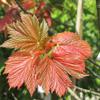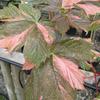Great choice! We're adding your items to the basket and working out what else you might need to plant it.
Variegated Sycamore Acer pseudoplatanus Simon Louis Frere
Example photos only. Size, stem height and habit may vary.
Please contact us for photos of current stock.
Select plant type
Quantity
British Grown – The British Grown logo denotes plants and trees that have been both propagated and grown in the UK. Read more
Product Description
ACER PSEUDOPLATANUS SIMON LOUIS FRERE - Variegated Sycamore
Characteristics
A medium tree Acer pseudoplatanus Simon Louis Frere is a very attractive, variegated form of the common Sycamore. Smaller and slower growing than the original it will only reach about 15m (48ft) in height, with a broad, round to pyramid-shaped crown. This trees main feature is its variegated leaves that open pink before tuning green with cream and white speckles in the summer. A good tree to plant in contrast to darker maples, such as Acer platanoides Crimson King or Acer platanoides Crimson Sentry.
Where to grow
It will grow well on even the worse soils, and can cope with both air pollution and even sites with salty sea winds. Like many of the variegated maples it is prone to reversion that must be pruned out as soon as it appears.
Did you know?
These variegated forms were popular in the late Victorian period especially in Northern Europe. Other similar variegated Sycamores are Tricolor and Leopoldii.
Features
-
Mature Height
- Medium - 10-15 metres
-
Spread
- 5-10 metres
-
Shape / Habit
- Round Headed
-
Growth Rate
- Medium
-
Soil Type
- All soil types
-
Sun Levels
- Full sun
-
Difficulty / Hard to Grow
- Easy
-
Evergreen / Deciduous
- Deciduous
-
Leaf Colour
- Green and Yellow (variegated)
-
Foliage
- Dense
- Large Leaves
-
Uses
- Screening
- Parkland Tree
- City/Urban Sites
-
Season
- Spring
- Summer
Aftercare
Pruning Acer Pseudoplatanus Simon Louis Frere
Acer pseudoplatanus Simon Louis Frere is a low maintenance tree and requires very little to no regular pruning. New growth can bring leaves that have reverted to plain green, so remove these shoots in order to retain the leaf colour.
Prune out any diseased or damaged stems, cutting flush to the main stem is the best method.
What time of year should I prune? Prune in winter (November to January) when the plant is dormant. Acers will bleed sap if pruned too early
For the continued healthy growth of your trees, shrubs or hedging it is vital that you follow the advice below.
Watering
The main reason that plants die within 12 months of having been planted is lack of water. It is essential throughout the spring and summer, to give a heavy enough watering to enable the water to penetrate right down to the deepest root level of the tree. In hot dry spells give the equivalent of 2 bucketfuls every three days.
Weed Control
One of the most common causes of lack of water is competition from grass. When trees are first establishing, the grass roots would be at the same level as the tree roots and are far more efficient at taking up water and thus choke the tree. It is vital that for at least 3 years after planting your tree or hedge has a circle or strip one metre wide completely free of grass.
- Mulch mats are an effective way to stop grass and weeds, although they will require a careful eye to make sure they continue to work. After clearing the ground around the tree, firmly fit the mat by tucking the edges into the soil and put a thick layer of bark mulch on top of this. Be careful not to allow the woodchip to touch the stem as it can cause rot.
- Weed killer is very effective, however it is harmful to the environment. Organic weed killers usually do not kill roots. Weed killer needs to be applied each year for the first 3 years, preferably when the tree is dormant, or just once before applying a mulch mat.
- Mowing or strimming is NOT an answer to the problem. Each time you mow, the grass will grow back more vigorously and strimming invariably leads to lacerated trunks.
Staking
If trees are not correctly secured they will rock in the planting pit. Roots not firmly in contact with the soil are unable to take up moisture and nutrients, resulting in die back or death of the tree. Check, particularly after windy weather, that stakes are still solidly in the ground keeping the base of the trunk firm. The purpose of the stakes is to anchor the roots. Flexing in the wind, higher up the trunk, is not necessarily a problem if the roots are firm.
Bellow is list of the correct system to use to secure your trees.
- 40/60, 60/80, 80/100 whips - Unless rabbit/deer problem no need to stake.
- 100/125, 125/150 1.2m Cane and Easi tie.
- 150/175 1.2m square stake and a buckle tie and spacer.
- 175/250, 6/8, 8/10 15L 1.65 Tree stake and a buckle tie and spacer.
- All larger trees. 2 x 1.65 Tree stake and cross rail with 38mm cushion spacer and 1m of 38mm strapping.
Ties
Always use our recommended tree ties or strapping. These are designed and manufactured with the correct amount of give to hold the tree firm without strangling it. They should be checked at the end of each growing season for adjustment as the trunk thickens. Non proprietary materials such as baler twine will cut into the bark and should not be used.
Protection from Animal Damage
Rabbits, deer, sheep, cattle and horses can all potentially damage trees. Ask us for advice on the most appropriate guards for your trees or hedge. Squirrels are also a terrible pest when trees get to about 20ft tall but there is no protection available.
Are the delivery costs the same no matter how many plants I order?
Yes the delivery costs stay the same no matter how many plants you have on your order. They are worked out based on your distance from our nursery and can be found here.











